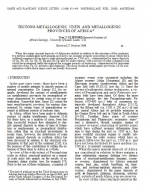Добрый день, Коллеги. Важное сообщение, просьба принять участие. Музей Ферсмана ищет помощь для реставрационных работ в помещении. Подробности по ссылке
Tectono-metallogenic units and metallogenic provinces of Africa
When the major mineral deposits of Africa are studied in relation to the structure of the continent, two tectono-metallogenic units emerge, as follows: (a) younger orogens consisting of zones which have suffered orogenesis from time to time during the past ca. 1200 m.y. - characterised by major deposits of Cu, Pb, Zn, Co. Sn, W, Be and Nb-Ta; and (b) older cratons, with a record of older orogenesis but which have remained stable throughout the younger periods of tectonism - characterised by important deposits of Au, Fe, Cr, asbestos and diamond. The more localised metallogenic provinces of ore concentration within these major units are briefly discussed.
In the past sixty years, there have been a number of notable attempts to classify regions of mineral concentration. De Launay [1], for example, developed the concept of metallogenetic (or metallogenic) provinces for geographical regions characterised by certain types of ore mineralisation. Somewhat later, Spurr [2] coined the terra metallographic provinces for regions characterised by certain types of mineralisation repeated at different periods of geologic time.
In Africa, efforts have been made to delineate regions of similar metallogenic character [3,4] but these have, in a number of cases, been less than successful because they attempted to classify mineral deposits in terms of time of formation or emplacement, or geographical distribution, rather than on structural environment. In recent years, however, the distribution of some major mineral deposits in southern Africa has been discussed in relation to the structural configuration of that part of the continent [5,6]; it is the purpose of this contribution to outline the extension of these ideas to Africa as a whole.
In view of the wide extent of Precambrian rocks in Africa, structural analyses on a regional scale must rely mainly on the results of ra-diometric dating studies (see, for example [7]). Prior to the use of these techniques, a number oforogenic events were recognised including: the Alpine orogeny (Atlas Mountains) [8]; and the Hercynian orogeny (northwestern Africa and the Cape fold belt) [9,10,11] (see fig. 1). Since the advent of radiometric dating techniques, a variety of Precambrian and early Paleozoic orogenic belts have been dated. Of these, the more modern include: the late Precambrian-early Paleozoic (450-680 m.y.) belts of orogenesis extensively developed throughout Africa [12-15]; and the Kibara belt (ca. 1100 ± 200 m.y.) of east and central Africa and its probable extension in the Orange River belt and in Natal in South Africa [14-16]. Together, these zones of younger Precambrian and Phanerozoic orogenesis repre-" sent a distinctive, though complex, regime of younger \orogens consisting of mobile zones which have suffered orogenic deformation from time to time during the past ca. 1200 m.y.; this more youthful structural regime is readily subdivided from the older cratons which have remained stable over the past ca. 1500 m.y. and have not been disturbed by more modern (ca. 1200 m.y. to present) orogenesis. <...>




